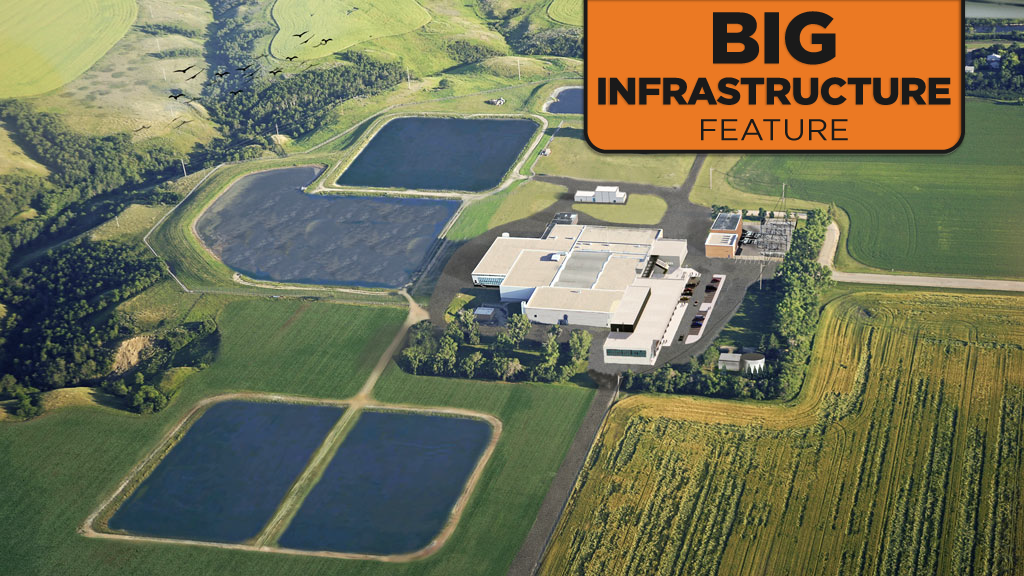After more than a few years of planning and studies, a $295 million, a three-year renewal of the Buffalo Pound Water Treatment Plant in southcentral Saskatchewan is now underway.
Construction by the joint venture team of Graham and Aecon, working under a progressive design-build lump sum contract, started in early June and is expected to take until 2025 to complete. The construction phase was preceded by two years of pre-construction and engineering design.
Carried out on behalf of the Buffalo Pound Water Treatment Corporation, the non-profit agency which owns and operates the plant, the project is a major renovation, with some elements of new construction and demolition.
Consultants for the corporation include Jacobs Engineering with the KGS Group and Carollo Engineering, while the joint venture’s consultants are Stantec and Associated Engineering.
The final hurdle to proceeding with the project was overcome this past May when the corporation received authorization from the cities of Regina and Moose Jaw to borrow up to an additional $55 million for the renewal, says the corporation’s CEO, Ryan Johnson.
For the past two years the corporation has been working with the joint venture team on the design development. But a variety of factors including the COVID 19 pandemic, supply chain bottlenecks, and inflation increased the project costs by $72.8 million. The authorization to borrow up to $55 million with the corporation’s reserves covering the increased expenses.
With the authorizations in place to borrow the necessary funds, the corporation was able award the construction services contract for the Plant Renewal Project, he says.
Located approximately 28 kilometres northeast of Moose Jaw, the plant has provided potable water to more than 260,000 residents in that city, Regina and the surrounding region. In operation since the 1950s, it treats water drawn from Buffalo Pound Lake, a manmade lake created in the 1930s.
“The water is safe, but we need to improve the plant’s efficiency,” says Johnson, explaining the last time the plant was upgraded was in the 1980s, and that the renewal is critical to ensure the corporation can deliver water of quality to its customers.
Plant personnel have to contend with problems such as out-of-date technology, adhering to new provincial regulatory requirements, and dealing with the changing nature of the lake, which is a ‘eutrophic’ lake—which means it is vulnerable to organics growth, he says.
Dating back several years, those issues were the catalyst for a 2017 plant renewal or business case study in which Jacobs Engineering evaluated 17 different options including building a new plant versus a major retrofit, says Johnson.
“Somewhat surprisingly the costs (building new or retrofitting) were almost the same.”
Jacobs was also asked to examine different procurement models and a major conclusion was that the progressive design build was the best option to reduce risks for the corporation, as it would be full partner in the design.
“I would certainly recommend it, at least for large projects.”
Progressive design build was the model the corporation adhered to as the project went through two planning stages, first a Request for Qualifications. and then a Request for Proposals from short-listed consortiums.
“We decided the market should decide,” says Johnson, explaining it was up to bidders to make the case whether the renewal should be a new plant or an extensive renovation of the existing facility. The Graham Aecon joint venture emerged as the successful bidder with its plan to revitalize the plant through a combination of new and retrofit construction and began the engineering design in 2020 in collaboration with the corporation. The construction phase was awarded this spring and site mobilization started in early June.
The renewal project will allow for the implementation of new technologies and will increase the plant’s treatment capacity to 250 MLD from the current level of 205 MLD, says Graham’s manager of water, Mark Livingston.
Some of those new technologies include flash mixing, flocculation, ozone contractors, and dissolved air flotation (DAF)—which is system for dealing with colour and algae problems.
With its combination of new construction, retrofit work, and demolition, including the installation of underground utilities, the construction of new lagoons and the clean-up of existing ones and the building of a new administration and laboratory facility, the project is a “significant undertaking.” By the summer of next year, anywhere from 200 to 250 workers will be on site, says Livingston.
To minimize the impact on the day-to-day operation of the plant, the project will be carried out in “process by process” staging system.
Other measures include detailed planning, close coordination with the plant operating staff, and adhering to “look ahead windows” where work is planed 90 days in advice. That is especially critical when new components and systems are tied into the plant.
When that happens there may be plant shutdowns as long as eight hours, but the advance planning will allow Regina and Moose Jaw “to fill up their reservoirs.”
Asked about some of the challenges, Livingston cites seasonal flows and the competition for skilled trades and materials in the region, which has multiple mining, power, and agricultural projects underway, plus the plant’s age. “There are always surprises when working on 70-year-facilities.











Recent Comments